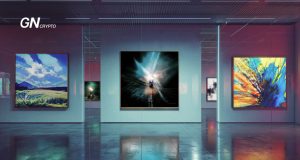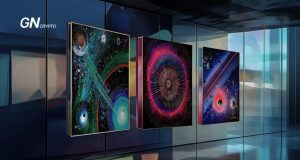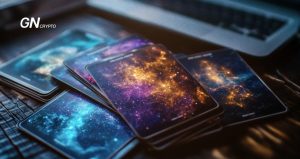Zeblocks: Two Masters at the Confluence of Disciplines

Zeblocks is a creative duo that crafts NFT collections, merging artistic imagery, virtual reality, and music into a cohesive digital experience.
On this page
The initiative was co-founded by Guillaume, an artist, and Sebastian, a programmer. Guillaume, who graduated from an art college, devoted himself to abstract painting and established his own web agency by the ripe age of twenty. His career encompasses a wide range of digital design endeavors, from crafting business cards and billboard ads to website design and beyond. Intrigued by decentralized technologies, Guillaume pivoted his focus towards blockchain ventures.
Sebastian, on the other hand, showed an early affinity for technology, embarking on his journey into computers and programming at just eight years old. By fourteen, he was already fluent in PHP coding. With time, his expertise expanded into leading projects in C++ and Python. Following the university education, Sebastian immersed himself in the tech startup scene, eventually gravitating towards blockchain development, a cornerstone of Zeblocks today.
Sebastian is the brain behind Zeblocks and without him there would be no interactive experience or amazing applications,
say Zeblocks themselves.
Their first major foray into the NFT world was with Unigrids, a generative collection on the Ethereum blockchain that blends abstract designs with animation and music. The uniqueness of each of the 421 NFTs lies in distinct characteristics such as pattern grid size, shape, color variety, palette, and musical rhythm. Unigrids gained notable attention, earning a spotlight in a digital auction at Sotheby's.
Unigrids Collection. Source: Official OpenSea website..
The creators emphasize that every visual and sound component exists purely on the blockchain, sidestepping the common practice of external sourcing. For instance, the visuals and animations are crafted through JavaScript-generated vector graphics, intentionally foregoing additional libraries to eliminate reliance on external loading. At the time of writing, the floor price for a piece from the Unigrids collection stands at 2.79 ETH (approximately $10,200).
Following the Unigrids release, the team introduced Beatboxes, a VR-based digital series. Comprising 841 NFTs, each Beatbox is a futuristic, geometrically designed room adorned with abstract elements and complemented by music. Unique attributes such as lighting, color palette, and musical tone contribute to each room's rarity. These virtual spaces can be explored with VR headsets or through a conventional monitor.
For creating the virtual reality space, the developers used the web framework A-Frame. According to the authors, they were among the first to apply this technology in a generative project. Zeblocks also enhanced sound quality, resulting in beats that were superior to those in Unigrids. All components of the collection were also placed on the blockchain. Currently, the minimum price fluctuates around 0.1 ETH ($365).
Another collection they launched is the generative series Sensthesia on the Ethereum blockchain. While it bears some resemblance to Unigrids, it's markedly unique. Instead of generated tracks, the NFTs use a microphone to capture surrounding sounds in real-time and create an image animation. In other words, any external sounds, be it music or ordinary conversation, transform the artwork into a sort of music player animation.
Sensthesia Collection. Source: Official OpenSea website.
The team has launched 469 NFTs under the Sensthesia banner, featuring a variety of traits. They opted for JavaScript and HTML5's Canvas for image creation, moving away from vector graphics to enhance the synchronization of animations with external sounds. The floor price for Sensthesia NFTs is set at 0.12 ETH ($439).
Beyond their proprietary projects, Zeblocks also contributes to the development of other NFT collections, such as a series celebrating the iconic boxer Muhammad Ali. This suggests that the creative and technological journey for Zeblocks is far from over, with more generative collections on the horizon.
The content on The Coinomist is for informational purposes only and should not be interpreted as financial advice. While we strive to provide accurate and up-to-date information, we do not guarantee the accuracy, completeness, or reliability of any content. Neither we accept liability for any errors or omissions in the information provided or for any financial losses incurred as a result of relying on this information. Actions based on this content are at your own risk. Always do your own research and consult a professional. See our Terms, Privacy Policy, and Disclaimers for more details.




























